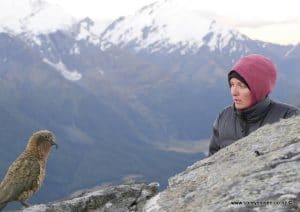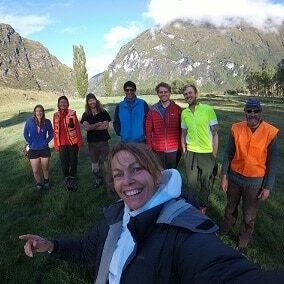Funded by Auckland Zoo Conservation Fund. Equipment funded by Craig Butcher. Supported by DOC Wanaka.

This project aims to develop a community kea catch trip, survey and nest monitoring program for the Matukituki Valleys, Mt Aspiring National Park (NP). This will be achieved by: i) running an initial catch trip to enable attachment of transmitters and bands to adults and bands to fledglings and juveniles, ii) monitoring kea nest productivity and predator impact through the breeding season and, iii) running a kea survey in January 2017 and combining with all other data to provide a baseline for the local kea population.
2019 Results
For the first time, our survey team encountered a perfect weather window and were able to visit 13 sites between 3 - 8 February 2019.
West Matukituki: Shotover Saddle, Aspiring Hut, Cascade Point, Cascade Saddle, Liverpool Hut, Scott’s Rock Bivouac, French Ridge Hut, Gloomy Gorge and Rob Roy Stream. East Matukituki: Duncan’s Knob, Sisyphus Peak, Wilmot Saddle and Albert Burn Saddle.
A total of 23 new kea were captured and banded and two adult females were fitted with radio transmitters.
Out of the 23 kea, 6 were fledglings which was very exciting to see. Three of these were hanging around with an adult pair - Isobel and Beau Jangles.
Lead Testing
Some of the captured birds were tested for lead levels and only one returned elevated levels (26.2 ug/dL). This would indicate that there is access to lead somewhere in the area but it is not a significant problem.
A large amount of lead was found and removed from a site just behind French Ridge Hut. It was clearly a remnant from the old hut in an old burn pile. The lead had melted in large clumps and would have been a significant risk to kea for the time it had been left there.
General Population Observations
Kea abundance this year was much higher than in previous years. Fledglings were present in the groups that were encountered at the survey sites, indicating there had been some successful nests in the area and that the survey period was adequately timed to coincide with these recent fledging events.
Follow up
October 2019 - All four female kea with transmitters (Kelly, Volta, Monty and Isobel), were either tracked to a point on foot or remotely tracked via radio telemetry. None of the kea were found to be nesting, with transmitter outputs showing high activity. This was enough to confirm that they were not nesting or frequenting a potential nesting cavity.
Tatra, the adult male with a transmitter fitted, was not located. The last known location of Tatra was in the West Matukituki between Liverpool and French Ridge Huts.
A large feral tabby cat was seen on the station near Cameron Flat. Reports from one of the farming contractors were that cat sightings are fairly regular on the station.
Moving forward 2019 and beyond
To date, no nests or breeding activity has been recorded within the survey site and only one fledgling was sighted up until February 2019 when 6 fledglings were caught and banded. The reason for the lack of documented breeding activity may be a result of high predator numbers re-invading the area. Of additional concern is that after a heavy mast this year, food availability in the forests is at an all-time high which although good for native species productivity, will also likely result in a boom in predator numbers South Island wide, further impacting kea populations. Since 2013, the Matukituki Charitable Trust (MCT) has actively undertaken ground-based predator control in the Matukituki valleys. Between the period April 2019 – May 2019, 761 pests were caught, including 68 mustelids and 26 feral cats (a rising phenomenon in the valley since 2015). Additionally, DOC has carried out 2 aerial operations in the area (2015 and 2017 with another scheduled for 2019/2020). Understanding how predators are impacting resident kea and breeding success is crucial for ongoing recruitment in the valley.
As such a new project is proposed from 2019 onwards with the following aims; i) ascertain sub-adult and adult kea survivorship in the Matukituki Valleys; ii) monitor kea breeding success in the study area and iii) understand predator interaction and risk to a population of kea, east of the main divide.
2018 Results
In January 2018, the annual summer catch trip was cut short due to a cyclone however 6 kea were still able to be caught and banded over the 3 day period and the blood lead levels of one subadult female was tested (7ug/dL). No fledglings were sighted.
2018 Follow up
March and April 2018 - Two follow-up trips were carried out by a small team resulting in the capture of a juvenile female in March and the recapture of two kea in April - one of which, an adult male Tatra, was also fitted with a transmitter. Signals for all other transmitters (Kelly, Monty and Aspiring), were acquired.
October and December 2018 - Three of the four radiotagged kea were confirmed alive and not nesting (2 subadult females and 1 adult male) while the adult female, Aspiring, was unable to be located. This may indicate that she is nesting in a 'black spot" or has moved to another valley.

2017 Results
A second kea survey was run from the 20th -29th January 2017 in the east and west Matukituki Valleys. Five kea were caught during the trip, one adult female, two adult males and two fledglings. Bands were attached to all captured birds and a radio transmitter was attached to the adult female (named Aspiring) to allow her to be monitored during subsequent breeding seasons.
2017 Follow Up
November 2017 - Aspiring, was followed throughout the 2017 breeding season to ascertain nesting activity and outcomes, however she was not found to be nesting. Aspiring was located in Gloomy Gorge on the 1st November to the east of French Ridge hut and visited the hut that evening with 5 other kea; an adult male, an adult female, a sub-adult female and two juvenile males.
The adult male and both juveniles were caught and banded and the sub-adult female (named Monty) was banded and fitted with a transmitter. This will enable her to be followed up in subsequent years as she matures.
December 2017 - Five banded kea were sighted at Aspiring hut between the 21st and 23rd December. Aspiring (adult female w/ tx), Barff, Basso, Dew and Flow were part of a flock of 12 kea to visit the hut.
A total of six kea were newly banded on the evenings of the 21st and 22nd December. These were made up of two sub-adult males, two juvenile males a juvenile female and a sub-adult female. A tx was placed on the sub-adult female (named Kelly) for future nest monitoring.
At the conclusion of the trip, one kea remained unbanded from the flock of 12. One unbanded adult female was also briefly sighted at French Ridge Hut.
2016 Results
An initial catch trip to be run in partnership with the Department of Conservation Wanaka was planned for the 16th – 22nd March 2016 (as part of a combined threatened alpine species initiative which also takes into account Rock Wren). The aim was to identify and catch up resident adult females and attach radio transmitters to enable tracking back to nest sites this breeding season.
The trip was initiated in the East Matukituki Valley with the kea catch team. A number of kea were sighted during the pm/am survey on the 17th – 18th March up the East Matukituki Valley (1 adult female (with a possible fledgling) at point 2 and 5 juveniles at point 3, however no birds were caught. On the 19th March, the trip was postponed due to heavy rain.
The catch trip has now been rescheduled to restart at the end of January 2017 and will be run in conjunction with the summer survey. Weather at this time should be more settled and breeding pairs with fledglings more easily identified on the hills.
